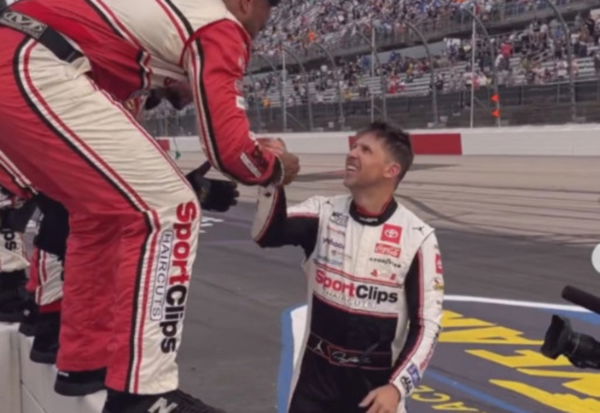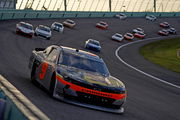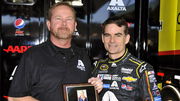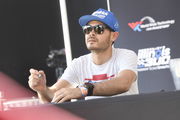

“This one certainly is one that I didn’t deserve really as a driver.” was a blunt admission by Denny Hamlin. Darlington Raceway, the track too tough to tame, was living up to its name. Hamlin was running third, battling hard but staring at a gap that seemed impossible to close. The leader was strong, the field was packed tight, and under a caution flag, everyone rolled onto pit road bumper-to-bumper. In moments like these, it’s not just about driving—it’s about the whole team executing flawlessly.
Hamlin knew how much luck and teamwork played a role, and his pit crew delivered in a way that still gives chills. A jaw-dropping 8.3 seconds. That’s not just fast—it’s the kind of speed that changes the race. And that pit crew? They didn’t just do their job. They created a moment that flipped the leaderboard and handed Hamlin the lead when he rolled back onto the track.
ADVERTISEMENT
Article continues below this ad
Denny Hamlin dissects what goes behind a solid pit stop
This wasn’t about having the fastest car or leading every lap. It was about trust, precision, and a moment of brilliance that turned a good day into an unforgettable one. What makes this win so special is Hamlin’s honesty about the struggle. He admitted he almost gave up mid-race, feeling the triumph slip through his fingers. “I was ready to surrender,” he said in a bombshell confession, but something kept him grounded—a risky move, a gut call, and trust on his team. That trust paid off when his crew delivered under pressure, turning a setback into a stunning victory.
Hamlin broke it all down, giving credit where it was due. He didn’t talk of himself as the hero—he dissected the technical bit that goes on a pit road. “Well total time is yellow line to yellow line,” he explained, painting a picture of how pit stops work. “So that on pit entry, you start the stopwatch, and when you leave pit lane, you stop the stopwatch—that is total time on pit lane. Now that it gets broken up into, you know, what my job is, and that is to roll as good as I can, exit the pit stall as good as I can. I have a responsibility to the total pit time as well, so it’s not just about, you know, if the total pit time, let’s just make it up, is 40 seconds at Darlington, the pit crew is responsible for eight and a half of that. You know what I mean? I’m responsible for the other part of it, and I can’t leave anything every second counts.”
Even Hamlin’s former NFL pit crew member, Mike Hicks, couldn’t stop raving about that 9.9-second stop. He said, “It took, I’d say every bit of the off-season [to reach the level they are at], but NASCAR like pit road – It’s a place where Murphy’s Law is very real… Like, okay, you could do it out of practice a million times, and you’re good. Then you get to pit road, and it’s just like bullets start flying.” Can you fathom the pressure?
One slip, and it’s game over, but Hamlin’s crew was locked in, helping him charge to a top finish. While others, like Ryan Blaney, were battling pit road disasters—loose wheels, slow stops, you name it—Hamlin’s team was out there making it look effortless. This prompted Dale Earnhardt Jr. to call out their mistakes. But Hamlin’s got a squad that’s firing on all cylinders.
Hamlin also dug into the strategy that makes those moments possible: “They can do it, but you know, it’s gonna have to be, you’re gonna have to have almost the perfect storm. They knock it out of the park, and then maybe, you know, whoever came in the leader has a subpar pit stop. Then you got a chance. I mean, under a caution flag pit stop like this, how can you actually beat another driver? You get in and out right because you’re bumper-to-bumper entering pit road.” It’s the kind of wisdom that comes from years of racing, of knowing that every second counts and every team member matters.
Kevin Harvick, breaking it down on his Happy Hour podcast calling it “pit crew magic,” marveling at how Hamlin’s team turned a solid run into a victory. Harvick pointed out the angles Hamlin took on the pit road, shaving off distance while staying within the rules. Rumors of speeding were shut down fast by NASCAR, by the way. On NASCAR’s weekly “Hauler Talk” podcast, Mike Forde, Managing Director of Racing Communications said, “Pit road speed is 45 mph [at Darlington]. We give a buffer of 5 mph,”. Forde explained further, “The No. 11 actually didn’t even come close to going too fast. The last section, the 11 car was at 47.79 mph. Every other section it was near 49 mph.” It was clean, calculated, and clutch.
What’s your perspective on:
Is Denny Hamlin's Darlington win proof that teamwork can outshine individual talent in NASCAR?
Have an interesting take?
Hamlin’s belief in his crew, their belief in him, and the lesson he left us with: never leave anything on the table. At Darlington, every second mattered, and they fought for everyone. That’s the miracle to carry with, a reminder of why NASCAR isn’t just a sport. It’s a story of heart, hustle, and moments that make one believe anything’s possible.
Trending
Life came full circle for Denny Hamlin at Darlington
2004 Darlington race was where Denny Hamlin, a kid from Virginia with big dreams, caught the eye of Joe Gibbs Racing. Racing trucks for EJP Racing—decent finishes like 10th at Indianapolis, 16th at Richmond, but nothing screamed superstar. He wasn’t even supposed to be there, just filling in for a late-model stock car event. But man, did he make it count.
ADVERTISEMENT
Article continues below this ad
Joe Gibbs shared a story at a media event, “Everybody loves coming to Darlington,” he said, “I go all the way back to Denny when we first got him, our final test for him before we signed him, J.D., who found him, my son, said, Let’s put him at Darlington. He’d never been here. Let’s put him in an Xfinity car and see what he does. He finished eighth. J.D. told me, he said, I think we need to sign this guy. I said, I agree.” With 56 wins, including back-to-back triumphs this year at Martinsville and Darlington, he’s only four shy of 60.
Then J.D. Gibbs threw him in the #18 Chevy Xfinity car at Darlington. What Denny didn’t know was that Gibbs and the sponsor, Rockwell Automation, had a deal: finish top 10, and you’re in for 2005. He nailed the eighth. That race locked in his Xfinity ride for two years. By 2005, Denny was juggling Xfinity and a Cup debut at Kansas. In 2006, he went all-in—full-time in both series. The guy didn’t just survive; he thrived, landing fourth in Xfinity and third in Cup.
Now, 20 years later, Denny’s a legend—54 Cup wins, a Daytona 500 champ, and still chasing that elusive title. Darlington’s got a hold on Denny Hamlin’s heart. It’s not just his recent win there, his 56th in the NASCAR Cup Series, that makes it special.
ADVERTISEMENT
Article continues below this ad
That victory came during NASCAR’s 75th anniversary, and it took him back to where it all began. All because one race at Darlington made J.D. Gibbs’ head turn. Makes you believe in destiny, doesn’t it?
ADVERTISEMENT
ADVERTISEMENT
ADVERTISEMENT
ADVERTISEMENT







Is Denny Hamlin's Darlington win proof that teamwork can outshine individual talent in NASCAR?